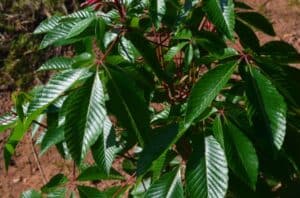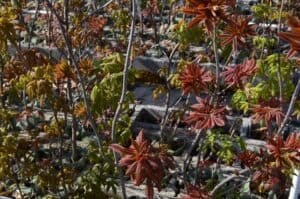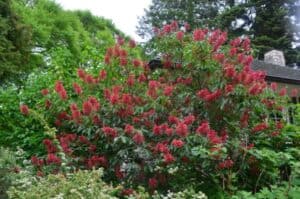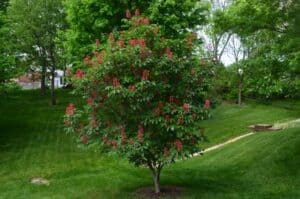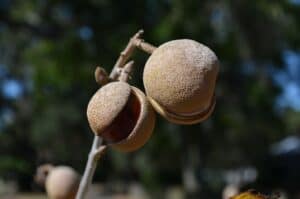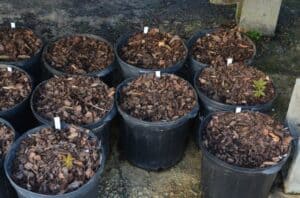Menu
close
Acer truncatum is certainly not a household word or common in the arboricultural, nursery and landscape industries, but it deserves greater use. Interest in this species is picking up as weather patterns are affecting tree performance. To date, this species has been adaptable to weather's curve balls.
Small trees, 20' to 30’ high and wide, with zone 3 to 9 hardiness, are rare, and this checks all those boxes plus wide soil adaptability. Michael Hayman of TreesLouisville and I frequently share information on tree species that embody worthy ornamental traits and urban tolerances. Our most recent discussion focused on Acer truncatum, an underutilized Chinese/Korean species (also Russia, Japan, and Manchuria listed). Mike is sourcing (testing) species and cultivars that prosper in the heavy, high pH, unamended soils of the Louisville area. He is frugal/careful with the non-profits’ resources and endeavors to be sure whatever is planted will survive/thrive. The species grows in many Chinese provinces (I counted 11) and the Korean Peninsula, to 3,300’ (Flora of China). The Morris, Arnold and U.S. National Arboretum hold wild collected specimens from China and Korea. The late Dr. John Pair, Kansas State University, championed the species for the plains and southwestern states. With such a wide native distribution, hardiness and other traits vary significantly, the most prominent examples being the emerging green to bronze-purple foliage (photo 1) and the yellow (pure), orange, to brilliant red (photo 2) fall colors.
Mike reported that every 20 years, fully foliated Acer palmatum (first week in April, Louisville) are killed outright and/or severely injured by late freezes. Buddy Hubbuch, horticulturist, Bernheim Arboretum, Clermont, KY, lost all Japanese maples but ‘Bloodgood’. Further, the great Don Shadow, Winchester, TN, lost 50 Acer palmatum cultivars except one from Hillier’s. Mike is growing the Hillier clone in Louisville where it is prospering. The merits of Acer truncatum include small tree size like A. palmatum, superior cold, heat, drought and pH tolerances, frost/freeze resistant young and mature leaves, and the potential for superb fall color with selected cultivars.
Let’s dissect/discuss the species and the superior cultivars characteristics. Acer truncation forms an upright-rounded to rounded crown, with strong branches, the foliage forming a dense canopy. (photos 3 and 4) Landscape sizes average 20 to 30’ high and wide. The U. S. National Arboretum has a wild collected, upright seedling in the germplasm repository (Beltsville, MD) which lends itself to street tree use. I observed specimen trees in Minnesota, Maine, Vermont, and Georgia, several reminding of large haystacks: others wider than tall. For 30 years, a small specimen grew at the UGA Horticulture Farm, consistently developing yellow fall color. Through those years, I did not observe heat and/or drought stress to the foliage.
Leaves emerge reddish purple/bronze purple, metamorphosizing to lustrous dark green, (3) 5 (7)-lobed, 3 to 5” wide, not as high, each lobe triangular, basal lobes long extended, entire (may have serrations), tips acuminate, truncate at base (not always), the petiole 2 to 4” long, exuding milky sap when detached. Fall color can be spectacular (November in Athens) and my notes in the Manual mention yellow-orange, yellow-orange-red, orange-red, and red, the latter specific to Main Street® and Fire Dragon®.
First year stems are glabrous, greenish to purplish red, turning brown when mature and marked with abundant pin-prick size lenticels. Winter buds are gray-brown, 6 to 8-scaled, the tips of buds pubescent. Bark is grayish brown, shallowly fissured, with longitudinal ridges. (photo 5).
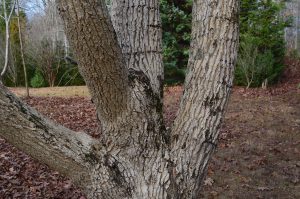
Photo 5
The yellow/yellow-green flowers, each1/3 to ½” diameter, 5-petaled, occur in ~10 flowered, terminal, erect, corymbose, 3” diameter inflorescences before or with the emerging foliage in April (photo 6). Flowers are usually dioecious with male and female on separate trees. This is not absolute as the lone University of Maine tree produced a small number of sound seeds. The fruits (samaras) are 11/4 to 11/2” long, spreading at obtuse to right angles, maturing in October-November. In the Dirr garden, Main Street® and Fire Dragon® produced minimal fruit.
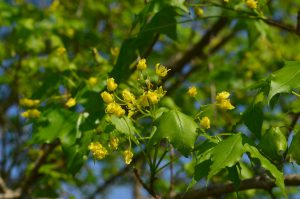
Photo 6
I receive mixed messages on absolute heat, drought and high pH tolerances. Most sources give high marks for tolerance to the above. Dr. David Creech, Stephen F. Austin State University Arboretum, Nacogdoches, TX, evaluated seedlings and cultivars for many years. His thoughts follow. Seedlings can be showy orange/red or blah. Main Street®, Fire Dragon® and Baby Dragon® are top fall color performers. He reported damage in the summer of 2023 when a long drought and temperatures to 112°F burned foliage and sun-scalded branches. Based on the many places I cataloged impressive specimens; the species embodies the genetic plasticity to tolerate wide variances in climate and soils. I estimate zone (3)4 to8(9) for hardiness/adaptability ranges, depending on the selection. Cornell University’s Woody Plant Database listed pH range as 5 to 8.
Sapsuckers will drill holes in rings around the trunk, but this does not injure the tree. I have never observed foliage damage from insects or diseases. Several Kentucky horticulturists who Mike surveyed mentioned Verticillium wilt on A. truncatum. They were less kind to the hybrids discussed below noting Verticillium and severe cold injury.
Seeds require at least 30 to 60-days cold-moist stratification although Dr. Pair reported shorter periods have worked. Sheffield Seeds recommends 4 months cold-moist stratification. Seeds should be soaked for 24 hours before being placed in the stratification medium. Cuttings from a 10-year-old tree rooted over 70% when treated with 1,000 or 5,000 ppm IBA. I know a Georgia commercial nursery that is rooting Main Street® from cuttings. Mark Andrews, Greenleaf Nursery, Park Hill, OK, mentioned it is not easy to vegetatively propagate; budding yielding 40 to 60% success.
Baby Dragon® (PP 26,612) exhibits pink to purplish red on new growth and subsequent flushes. The yellow fall color is mixed with red and orange and even pink in cooler climates. Grows 12’ high and 15’ wide with a dense, mounding and weeping habit. Introduced by Keith Johansson, Fort Worth, TX, who sold the company to Scott Hubble.
Fire Dragon® (PP 17,3670) exhibits vibrant fall colors, cardinal to currant red. Forms a round-headed canopy and is slower growing than Main Street® in the Dirr garden. The summer foliage is waxy, sheeny dark green; the vibrant fall colors consistently produced. Selected in Fort Worth, TX in 1999 and still not well known. Greenleaf Nursery lists size as 35’ high/wide and zone 5 hardiness. Originator noted 25 to 30’ high and wide in 12 years. (photo 7)
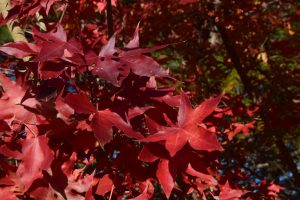
Photo 7
Main Street® (‘WF-AT1’, PP 20,109) was introduced by Worthington Farms, Inc., Greenville, NC. Mike Worthington brought me two trees, one was planted in the garden, the other at the UGA horticulture farm. The habit is oval-rounded, more upright than Fire Dragon®, the branches upswept, making it suitable for street tree use. The selection grows 20’ high and 16’ wide according to the introducer’s web site. However, my 12-year-old tree is 30’ high and 20’ wide. Fall color is consistently orange-red and, in the best years, comparable to Fire Dragon®. Zone 4 to 9. (photo 8)
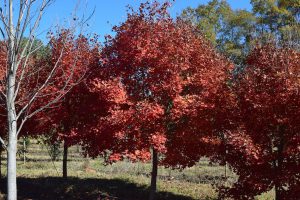
Photo 8
Super Dragon® (PP 26,414) features bright yellow-green foliage color in summer, a mix of golden yellow, cranberry red and white in fall. Grows 18’ high and wide.
My co-author on THE TREE BOOK, Keith Warren, J. Frank Schmidt Nursery, Boring, OR, bred and introduced hybrids with Acer platanoides, including Crimson Sunset® (‘JFS-KW202’), Norwegian Sunset® (‘Keithsform’), Pacific Sunset® (‘Warrenred’), Ruby Sunset® (‘JFS-KW249’), and Urban Sunset® (‘JFS-KW187’). The hybrids are thoroughly discussed in THE TREE BOOK, 2019, Timber Press. To date, the selections have not become mainstream, at least in the southeastern states. (photo 9. of pacific sunset at Oregon garden) The emerging purple tinged foliage (photo10 Urban Sunset®) matures lustrous dark green, developing shades of orange/red in autumn. The exception, Crimson Sunset®, with purple leaves (photo 11), that in the Dirr garden develops bronze-orange tints in fall (photo 12). Pacific Sunset® has performed better than Norwegian Sunset® at Milliken Arboretum, Spartanburg, SC, the former developing respectable yellow-orange fall color. Ruby Sunset® and Urban Sunset® produced orange to red fall color in mid-November in the Dirr garden (photo 13 ruby sunset). Ruby Sunset® flowers and foliage emerge much earlier than Urban Sunset®. The habits are oval rounded, rather stiffly branched, the branches upswept. Buds and stems of the hybrids are larger/thicker than those of Acer truncatum. Keith mentioned that the hybrids are not sterile.
Smaller trees that survive/thrive the vagaries of climate and soil are at a premium. Mike and I believe Acer truncatum is a leading candidate to partially fill the void.
Fifteen years ago, I penned a brief article on Nyssa for HMI's TreeTalk™ publication. The present discussion expands significantly on that information and discusses the advances in Nyssa selection, evaluation, and production techniques.
Recently, I was asked what I thought of Nyssa sylvatica as a replacement for Acer rubrum by Nate Nix, sales arborist, Monster Tree Service in Athens, Georgia. The company has worked with me and offers quality work at a fair price. Nate said a local Athens residential, golf, and tennis complex, wanted to install 1,250 Nyssa sylvatica to replace the red maples that have languished. I become apoplectic when one monoculture is being replaced by another. The heartbreaker was the proposal to use a single Nyssa sylvatica cultivar. I asked Nate about at least mixing cultivars and told him I would review what I consider the best selections.
In 2019, I was involved in tree selections for our Oconee County, Georgia, four-lane connector project. We planted 761 trees along the 3.5-mile length. Over half were Quercus species. Twenty-one Nyssa were installed, all seedlings, with rag-tag, motley habits, variable fall color, and tardy recovery after transplanting. More on this project in a future article.
The local Lowe’s replaced the parking lot trees with an avenue of seedling N. sylvatica. The variation in habits and fall colors from perpetually green to brilliant orange-red speaks to the need for clonal selections. On the University of Georgia campus, a uniformly branched female seedling tree with lustrous dark green leaves, consistent brilliant red-maroon fall color, and lack of leaf spot caught my eye.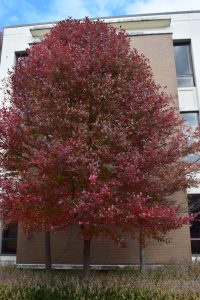 Hidden Hollow Nursery, Belvidere, Tennessee, budded it and I added one to the garden. The first year it contracted leafspot and now in the third year, I hope for better results. My most recent discovery of a unique Nyssa sylvatica occurred in June 2022, during a conference at Mount Vernon, Virginia. This female specimen is distinctly conical pyramidal in habit and the foliage lustrous dark green. Currently it is being propagated by Hidden Hollow Nursery and Moon's Tree Farm in Washington, Georgia. If worthy of introduction, it will prove a great street and garden addition where lateral space is limited. I should add that George Washington planted the species on the estate.
Hidden Hollow Nursery, Belvidere, Tennessee, budded it and I added one to the garden. The first year it contracted leafspot and now in the third year, I hope for better results. My most recent discovery of a unique Nyssa sylvatica occurred in June 2022, during a conference at Mount Vernon, Virginia. This female specimen is distinctly conical pyramidal in habit and the foliage lustrous dark green. Currently it is being propagated by Hidden Hollow Nursery and Moon's Tree Farm in Washington, Georgia. If worthy of introduction, it will prove a great street and garden addition where lateral space is limited. I should add that George Washington planted the species on the estate.
Most landscape architects, designers, and gardeners know little about Nyssa sylvatica, having been brainwashed by red maple ideology. There are eight Nyssa species worldwide, with N. sylvatica the best known and most important shade and ornamental species in North America. The species is native to Canada, Maine to Florida, west to Wisconsin, Michigan and Texas, in dry to moist habitats, including standing water. I have recorded trees in dry/rocky soil on Whiteside Mountain, North Carolina at 4,000 to 5,000’ elevation. In our Bogart, Georgia, garden, a 60’ tall female tree spreads seedlings through the 3.5 acres. I purchased the contiguous lot to preserve this magnificent 4-trunked work of art.
Nyssa sylvatica has received greater attention from nurseries with over 30 selections (see list below). Twenty years past there were less than 10 and few were commercially available. A major west coast nursery told me they could sell greater numbers, but propagation was more difficult than, for example, red maple. Nyssa sylvatica does not root from cuttings or, to my knowledge, respond to tissue culture. Winter grafting and summer budding work well. I have grown many seedlings by collecting the blue-black fruits in fall, removing pulp, floating seeds to determine viability (sinkers sound/viable), providing 90 days cold-moist stratification, often with germination (root radicle) in the cold.
The principal tree genera in nursery production in the U.S. in order of importance/numbers are Acer, Malus, Quercus, Ulmus, Cercis, Amelanchier, Tilia, Zelkova, Gleditsia, Gymnocladus, Prunus, Nyssa and Pyrus. Pyrus is on the way out due to non-native status and invasiveness. It is banned, or in the process, in several states including Ohio, Pennsylvania, and South Carolina. Fraxinus, ash, is not listed above as Emerald Ash Borer (EAB) rendered it a nonentity. Before EAB, the genus ranked with maple and oak in nursery sales.
Nyssa will continue to ascend commercially as new and better selections appear. Michael Hayman is assembling a collection of Nyssa sylvatica cultivars in Louisville, Kentucky. Mike is committed to building a genetic repository useful for evaluating cultivar performance and future breeding. His commentary on cultivars is presented below. The U.S. National Arboretum has been breeding Nyssa species for many years and has yet to release a selection. I visited the USDA's National Germplasm Resources Laboratory in Beltsville, Maryland, where hybrids of N sylvatica × N. sinensis and N. sylvatica × N. ogeche were being screened for leaf spot, canker, and leaf miner resistance. I grew N. ogeche, N. sinensis, and N. biflora; none possessing the quality attributes of N. sylvatica.
Habit is pyramidal in youth with open to densely set branches some of which are pendulous. At maturity, the horizontal branches form an irregularly rounded or flat-topped crown. The secondary branches are populated with numerous short branch spurs making pruning/climbing somewhat of an adventure. Occasionally, the lower branches, reminiscent of pin oak, sweep the ground, not exactly constituting a viable candidate for street tree use. Newer introductions like Forest Fire®, Green Gable®, Red Splyndor®, and Tupelo Tower™ develop upswept lower branches. Under landscape conditions, I estimate 30 to 50’ (60’) in height and 20 to 30’ (40’) in width. In our garden, there is a 60’ tall and 40’ wide, four trunked specimen. The National Champion is 78’ high, 95’ wide, with trunk circumference of 247”.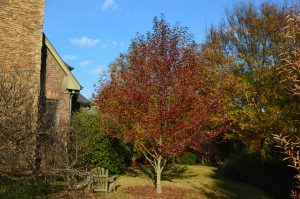
Foliage emerges later than many oaks, maples, elms, planetrees and is not fully developed until mid-May on the tupelos in the Dirr garden. Leaves range from flat/dull/matte to glossy dark green, developing fluorescent fall colors of yellow, orange, red, maroon and purple; often a kaleidoscopic mix. Without equivocation, one of America’s most consistent, beautiful trees in autumn. Leaves range in size from 3 to 6” long, 11/2 to 3” wide with entire margins, except for occasional mini lobes/teeth at the terminal, and the extended terminal apex. A fungus, Mycosphaerella nyssacola, produces black lesions on the foliage which cause premature defoliation in September-October. 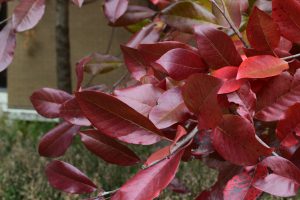
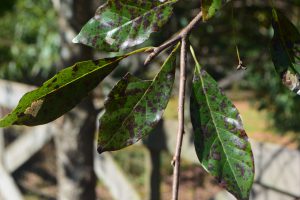 Appears more problematic in the southeast for cultivars like Afterburner™ are completely defoliated in the Dirr garden yet untouched in Mike Hayman’s Louisville trials. Red Rage™, a Hayman selection, and ‘Wildfire’, Steve Hottovy selection, are the most resistant in the Athens area. The disease is variable from year to year. In 2017, Green Gable® developed magnificent red fall color. In 2021, the same tree in our garden lost most leaves and those remaining did not color.
Appears more problematic in the southeast for cultivars like Afterburner™ are completely defoliated in the Dirr garden yet untouched in Mike Hayman’s Louisville trials. Red Rage™, a Hayman selection, and ‘Wildfire’, Steve Hottovy selection, are the most resistant in the Athens area. The disease is variable from year to year. In 2017, Green Gable® developed magnificent red fall color. In 2021, the same tree in our garden lost most leaves and those remaining did not color.
Flowers are polygamo-dioecious: bisexual (male and female parts in the same structure) and/or dioecious (male or female flowers on separate trees). Flowers open with the spring foliage; yellow-green male in many flowered rounded inflorescences;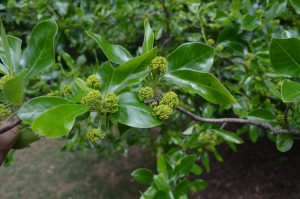 female in 2 to 4 peduncled axillary clusters. Bees are particularly fond of the flowers for nectar and pollen. It is considered a good honey tree. The fruit is an oblong, bluish black drupe, 3/8 to ½” long, ripening September-October. The fruits are sour but eaten by many species of birds and mammals. Fruits are high in crude fat, fiber, phosphorous and calcium.
female in 2 to 4 peduncled axillary clusters. Bees are particularly fond of the flowers for nectar and pollen. It is considered a good honey tree. The fruit is an oblong, bluish black drupe, 3/8 to ½” long, ripening September-October. The fruits are sour but eaten by many species of birds and mammals. Fruits are high in crude fat, fiber, phosphorous and calcium.
Nyssa sylvatica was always a difficult plant for my students to identify, particularly in winter. The ovoid, ¼” (3/8”) long buds are composed of variable colored, yellow brown to red-brown scales. The three vascular bundle traces form a cave-like entrance to the leaf scar. If still in doubt, cut the stem on the long axis and note the chambered pith. The dark gray, brown, brown-black bark on older trees is quite distinctive, often checkered into block-like/alligator hide patterns.
I believe Nyssa sylvatica is more adaptable to extremes of soil than given credence. Ideally, soils should be acid, moist, and well drained yet in the wild it grows in swamps, freshwater ponds, dry mountain ridges, abandon fields and mixed forest situations. In 2012, Bonnie and I visited the Jefferson National Forest in southwest Virginia. Mixed with oak, maple, birch, tuliptree, serviceberry, and blueberries were numerous black tupelos on the mountainsides among the rocks and rubble. Seedling trees were planted through the years at Mt. Airy Arboretum in Cincinnati, Ohio (park established in 1911; arboretum in 1930s). The soil is heavy clay, high pH and mature trees have never developed chlorosis. By observation/inference, the species is more high pH tolerant than given credence by the literature. The species is hardy from zone 4 to 9.
Nyssa sylvatica has a warranted reputation for being difficult to transplant because of the taproot and stringy root system. I mentioned 21 trees were installed along the Oconee Connector. These were ~4” diameter trees, the remnants of a seedling block that had not been root pruned. All survived but were slow to recover from transplant “shock”. In their 4th year, the leaf sizes were normal. Nurseries grow Nyssa sylvatica in grow bags, containers or, when field grown, root prune during production, thus minimizing loss. Bare root liners do not transplant well. Hale & Hines Nursery in McMinnville, Tennessee, produces beautiful trees in 15-to-45-gallon containers.
Below is a list of Nyssa sylvatica cultivars cobbled together from nursery catalogs, literature, and personal experiences.
| Afterburner® (‘David Odom’)
‘Autumn Cascade(s)’ ‘Big Momma’ ‘Carolyn’ Fire Master® (‘PRP 1’) Firestarter® (‘JFS-red’) Heavy leaf spot in Louisville. Forest Fire™ (‘The James’) Forum™ (‘NXSXF’) Green Gable™ (‘NSUHH’) Gum Drop® (‘JFS-PN Legacy 1’) ‘Hidden Hollow Dwarf’ ‘Isobel Grace’ ‘Jermyns Flame’ ‘Lakeside Weeper’ Majestic® (‘M.O.N.2’) ‘Miss Scarlet’ ‘Mount Vernon’ ‘Mt. Airy’
|
Nitro™ (‘BBN-01’)
Northern Splendor™ ‘Penwood Weeper’ ‘Red Jeanne’ Red Rage® (‘Hayman Red’) Red Splyndor® (‘NSMTF’) ‘Red Red Wine’ ‘Salem Weeper’ ‘Sheffield Park’ ‘Sheri’s Cloud’ Snow Flurries™ (‘Grechrist’) Tupelo Tower™ (‘WFH1’) White Chapel™ (‘Cherry Pie’) ‘Wildfire’ ‘Winchester’ (same as ‘Winning Colors’?) ‘Windsor’ ‘Winning Colors’ ‘Wisley Bonfire’ ‘Zydeco Twist’
|
To date, Mike Hayman has accumulated 21 selections/cultivars. I asked him for commentary on those he considered the best, based on performance in Louisville. My observations are in italics.
Mike noted it is difficult to pick the best because they vary year to year, and some haven’t been in the collection long enough to judge, but so far, using architecture/branch structure, leaf spot resistance, and fall color as criteria, these rated high.
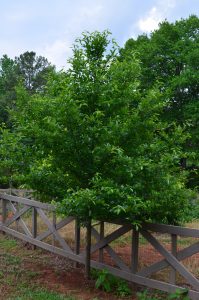 Afterburner® (‘David Odum’)- Prolific fruit producer. Usually good leaf spot residence in Louisville. Glossy leaves. High disease susceptibility in Dirr garden. Never had the opportunity to observe the rich red fall color since leaves had abscised.
Afterburner® (‘David Odum’)- Prolific fruit producer. Usually good leaf spot residence in Louisville. Glossy leaves. High disease susceptibility in Dirr garden. Never had the opportunity to observe the rich red fall color since leaves had abscised.
Fire Master® (PRP 1’)- Discovered by Phil Powell in western Kentucky, glossy leaves, smaller leaves than Red Rage®. Excellent red fall color. Good leaf spot resistance if in full sun. Female. Dirr has not grown. Observed with leaf spot in Louisville 9-13-16. 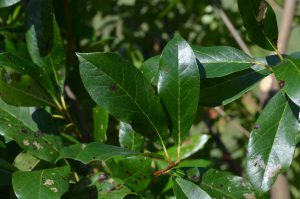
Green Gable®- Dense, upright habit, glossy leaves. Good against leaf spot. Found by Harald Neubauer, Belvidere, Tennessee. Male. Tree in the Dirr garden is upright conical-pyramidal with upswept lower branches. Fall color has been inconsistent. Great red when at its best. Terrific choice for areas where lateral space is limited.
Majestic®- Seedling of ‘Carolyn’ discovered by Ken Kazimier, Madison, Wisconsin. ‘Carolyn’ is a New Hampshire seed source so Majestic® should be very cold hardy but someone else will have to test cold limits. Little early to judge but so far doing very well in Louisville. Glossy leaves. Female. Yellow, orange, red fall color, according to Kuenzi Turf & Nursery. Dirr has not grown.
Red Rage® (‘Hayman Red’)- Big glossy summer leaf and easy to identify from the leaves. Red orange fall color usually. Found near Tell City, Indiana, in a fence row. Good against leaf spot if in full sun. Good branch architecture. Male. Excellent smaller version of the species. High leaf spot resistance in the Southeast. Consistent orange red fall color. Trees on the Georgia and Wofford College (Spartanburg, S.C.) campuses are outstanding.
‘Wildfire’- Burgundy spring foliage. Dense, wide, fast growing, almost certainly a southern seed source. Found by Steve Hottovy. Fall color sometimes. Good against leaf spot. Good architecture. Male. I have three in the garden. Fast growing and maintains a central leader. Branches are wide spreading, the lower arching. The emerging leaves are red, maturing green (May in the Dirr garden). Subsequent growth flushes still colorful. Fall color inconsistent and seldom great although in the Dirr garden and Georgia campus, trees have colored brilliant red. High resistance to leaf spot.
‘Winning Colors’ is a prolific fruit producer. Scarlet fall color. Good architecture. Good against leaf spot but not as glossy as Afterburner®. Dirr has not grown.
A few Dirr recommendations beyond Mike Hayman’s and my combined thoughts.
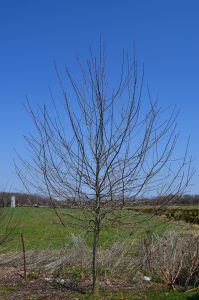 Forest Fire™ (‘The James’)- Upright oval to rounded crown, 40-50’ by 20-25’. Uniform branch structure, branches upswept. Glossy dark green leaves turn red in fall. Female. Introduced by Hale & Hines Nursery, McMinnville, Tennessee. Good leaf spot resistance on small tree in the Dirr garden.
Forest Fire™ (‘The James’)- Upright oval to rounded crown, 40-50’ by 20-25’. Uniform branch structure, branches upswept. Glossy dark green leaves turn red in fall. Female. Introduced by Hale & Hines Nursery, McMinnville, Tennessee. Good leaf spot resistance on small tree in the Dirr garden.
Nitro™ (‘BBN-01’)- Have only observed once. Large leaves, red-purple new growth. Red fall color. Listed 40-50’ high, 25-30’ wide. A sport of ‘Wildfire’, the leaves ~twice as large. Described as ‘Wildfire’ on steroids. Leaf spot resistance unknown. Perhaps like ‘Wildfire’. Introduced by Dwight Bottoms, Bottoms Brothers Nursery, McMinnville, Tennessee. Offered by Greenleaf Nursery.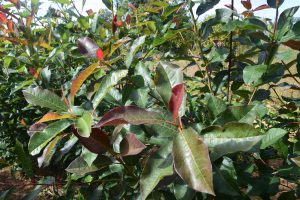
Red Splyndor® (‘NSMTF’)- Red Splyndor® maintains a central leader with upswept secondary branches forming a pyramidal-oval outline. Impressive, uniform, symmetrically branched tree. Foliage is lustrous dark green, various shades of red in autumn. Typically, clean foliage, although slight leaf spot on occasion. Sets some fruit. 50-60’ by 35-40’. Discovered by Dwayne Moon, Moon's Tree Farm. Dwayne and I work on many tree projects and currently are propagating the Mount Vernon Nyssa that was previously described.
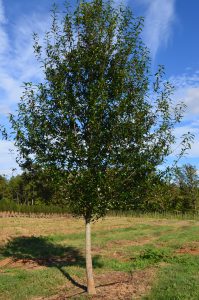
The Nyssa sylvatica story continues to unfold as new selections are made. I doubt there will ever be a perfect black tupelo. For Mike Hayman, Dwayne Moon, myself, and other arboricultural explorers, the joy is in the discovery, and numerous trees yet await our visit.
Aesculus, the buckeyes and horse chestnuts, comprise 13-19 species in the United States, Europe and Asia. Aesculus arguta, Texas buckeye, A. flava, yellow buckeye, A. glabra, Ohio buckeye, A. parviflora, bottlebrush buckeye, A. pavia, red buckeye, and A. sylvatica, painted buckeye, are reasonably well represented, at least in botanical gardens and arboreta from Minnesota to Georgia. Many of these species interbreed and hybrids are known. Aesculus californica, California buckeye, is a beautiful, white-flowered, broad-canopied tree found on dry hillsides in California. It is seldom cultivated in the eastern U.S., although pretty specimens are extant at the JC Raulston Arboretum, Raleigh, NC, and the Norfolk Botanical Garden, VA. The fruits/seeds are the largest of the U.S. species. I have grown and/or propagated all the eastern species, with A. flava, A. parviflora, and A. pavia sprinkled throughout our 3.5 acres, primarily in shady habitats.
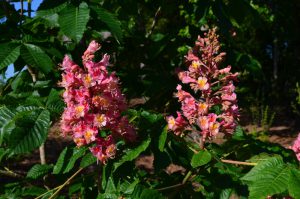
Flowering Aesculus x carnea
The rarest species in the garden are A. chinensis, Chinese horse chestnut, which has yet to flower, and A. ×carnea, red horse chestnut, which flowered consistently the past 10 years, although considered ill-suited to the southeast. The tree was planted in 2013 and is now 15’ high and 12’ wide. Sited in full sun (by definition at least 6-hours), but on the north side of larger pines and oaks, it exceeded expectations. It is the result of hybridization between A. hippocastanum, common or European horse chestnut, and A. pavia, red buckeye. The hybrid is thought to have arisen in Germany as a spontaneous seedling. This means that the two parents were in proximity and the unscheduled wedding occurred, resulting in this magnificent, lustrous dark green leaved, rose-red-flowered, stately, medium-sized tree. I notice variation in the intensity of red flower coloration, so seedling trees, although purported to breed true-to-type, do not necessarily do so. I have collected seeds of the species but have yet to have a seedling flower. Aesculus flava seedlings produce flowers in their second and third years. To minimize thievery by squirrels, the fruits are collected when the outer, light brown, leathery husk starts to split. The seeds of A. ×carnea are polished brown-black and ¾ to 1-inch diameter. Seeds are planted immediately, covered with wire/netting to protect from varmints. Seedlings develop a taproot soon after planting; the shoot appearing immediately or the following spring.
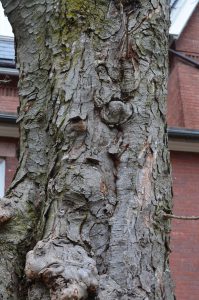
Aesculus x carnea bark
In England and the European continent, the species is common, with mature trees hovering between 40 to 50’ high and wide. The red flower color is more intense there, possibly because of the cooler day/night temperatures. The largest trees in the U.S. are found in the northern states, not quite as prosperous/large in Zone 8, yet quite respectable. My wife and I host visitors/tours in May, and the A. ×carnea ‘Briotii’ (see under cultivars) is the most asked about plant. What is it and where can I buy one?
Aesculus ×carnea and A. hippocastanum are often maligned because of the leaf blotch (Guignardia aesculi/Phyllosticta sphaeopsoidea) which causes brown, disfigured, and tatty leaves in summer-fall. The disease does not kill the trees. I have found that A. ×carnea is less susceptible and, based on the 10 years in our garden, worthy of greater use from zone (4)5 to 8a. The Dirr tree is minimally affected by the blotch with leaves persisting into November. In Salt Lake City, UT, during an October visit, I noticed A. ×carnea and A. hippocastanum mixed in a street tree planting. The former clean; the latter riddled with leaf blotch.
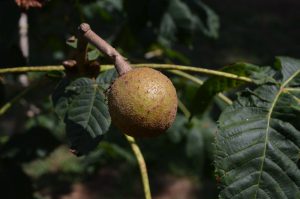
Aesculus x carnea fruit
The rose-red flowers are borne in 6 to 8” long, 3 to 4” wide terminal panicles in May. The tree flowers in late April into early May in Athens; a month later in the Boston area. The lustrous dark green, compound palmate leaves are composed of 5(7), 3 to 6” long leaflets, each with a slight undulating surface and serrated margins. Leaves may develop a tinge of yellow in fall. The buds, especially the flower (terminal), are ½ to ¾” long, and covered with dark chestnut brown, sticky scales. The stems are stout, gray; young trunks smooth and gray-brown; older becoming scaly and darker brown. The fruit covering has short spines, somewhere between the spiny fruit of A. hippocastanum and the smooth fruit of A. pavia.
The species is best adapted to moist, well-drained, acid or neutral soil, full sun to partial shade. Container and balled and burlapped trees transplant readily. Although the literature refers to lack of heat and drought tolerance, I have yet to observe leaf drop/browning.
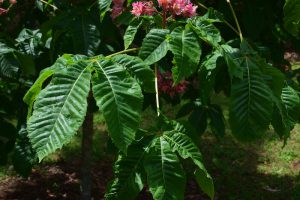
Aesculus x carnea Briotii flower
‘Briotii’, known as the ruby red horse chestnut, is commercially available. It originated from seed in 1858 at the Trianon in France. Flowers are deeper red and borne on 10” long inflorescences. I encountered many trees labeled as ‘Briotii’ and the flower colors do not always match the description. The tree in our garden was purchased as ‘Briotii’ yet the flower color is pink-rose rather than red. Ideally purchase the tree in flower. I speculate that other A. ×carnea seedlings may have been labeled as such.
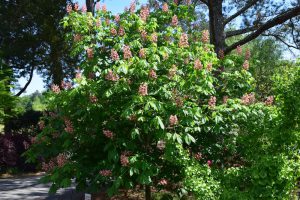
Aesculus x carnea Fort McNair
‘Fort McNair’ was selected for the increased resistance to leaf blotch. In Athens, I see little difference in susceptibility between this and ‘Briotii’. Certainly, a handsome tree and, without the label, I could not tell it from the Dirr ‘Briotii’. Selected on the grounds of Fort McNair, Washington, DC.
‘O’Neil’s Red’ has longer inflorescences (to 12”) and brighter red flowers than the above. A particularly beautiful tree grew in the Sarah P. Duke Gardens, Durham, NC, and flowered there in early to mid-May. Many spellings of the cultivar name. A reference mentioned ‘O’Neill Red’ was introduced by Monrovia Nursery circa 1979.
I believe an opportunity exists for intelligent/transformational breeding with Aesculus. The New World, A. pavia, serendipitously crossed with the Old World, A. hippocastanum; thus, other far-fetched species’ combinations may be possible. Hybrids of the eastern North American species like A. flava, A. glabra, A. pavia, and A. sylvatica are common and legitimized by GRIN taxonomy (see www.ars-grin.gov). Hybrids between A. parviflora and A. pavia would result in superb, pink-flowered offspring. I need to get back to the work at the breeding bench.
Carya species, hickory, native throughout the eastern, midwestern and southeastern United States, are seldom available in retail commerce. Primarily relegated to the deciduous forests, commingled with oak, beech, maple, tupelo and birch, few trees are more beautiful in autumn when aglow with the late developing, long persistent, rich yellow-gold foliage. Foliage shows significant frost/freeze tolerance in the range 24 to 28°F. I noticed hickories retaining fall color when adjacent species lost color or defoliated. From swamps (Carya aquatica) to mountaintops (Carya ovata) and sites between, a hickory resides. The nuts nourish all manner of wildlife and the pecan, Carya illinoinensis, is a major commercial tree, particularly in the southeast and southwest. There are ~18 Carya species and several hybrids. Eleven species occur in the U.S. with five of these extending into Canada. For a complete list of species worldwide, search germplasm research information network (www.ars-grin.gov) and plants of the world (powo.science.kew.org).
Leaves, flowers, and fruits
Hickories are tricky to correctly identify (ID), and hybrids make the process even more confusing. The following characteristics will lead the reader to the genus. After that, ID may become less clear/absolute. Leaves are alternate, compound pinnate with a central axis (rachis) and (3)5 to 19(21) leaflets, the terminal leaflet often the largest and obovate in outline; the lower leaflets oppositely arranged along the rachis. The leaf margins are serrate (toothed), surfaces pubescent or glabrous, and when bruised or crushed release a pungent odor.
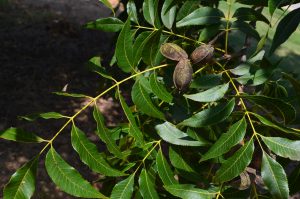 Flowers are monoecious, meaning in separate structures on the same plant. Flowers open with the leaves, usually around mid-April in the Athens area (zone 8a). Male flowers appear in long cylindrical catkins from buds of the previous season’s growth. The apetalous female flowers occur on the emerging shoots of the season, either solitary or up to 10 in a cluster. The nuts that follow develop from a single ovary with two stigmas, the seeds appearing as two but joined at one end. The top-shaped, rounded, to ellipsoidal (pecan) shaped nuts are covered with a husk that typically splits along four suture lines. Fruits mature in October-November and the dehisced nuts are often evident under the tree. The seeds are high in unsaturated oils and serve as an important food for wild animals and birds. Pecan, C. illinoinensis, is an important commercial nut tree with a value of over 399 million in 2020.
Flowers are monoecious, meaning in separate structures on the same plant. Flowers open with the leaves, usually around mid-April in the Athens area (zone 8a). Male flowers appear in long cylindrical catkins from buds of the previous season’s growth. The apetalous female flowers occur on the emerging shoots of the season, either solitary or up to 10 in a cluster. The nuts that follow develop from a single ovary with two stigmas, the seeds appearing as two but joined at one end. The top-shaped, rounded, to ellipsoidal (pecan) shaped nuts are covered with a husk that typically splits along four suture lines. Fruits mature in October-November and the dehisced nuts are often evident under the tree. The seeds are high in unsaturated oils and serve as an important food for wild animals and birds. Pecan, C. illinoinensis, is an important commercial nut tree with a value of over 399 million in 2020.
Bud, stem, bark and wood
Winter buds vary from species to species and are described within the species’ descriptions that follow. Bark is likewise variable and the shaggy bark of C. ovataand C. laciniosa, is instantly recognized. Carya glabra and C. tomentosa are smooth barked in youth, developing ridged and furrowed bark with maturity. Tree bark of Carya aquatica is smooth in youth, then slightly roughened/scaley in old age. The wood of hickories is used for furniture, flooring, cabinets, veneer, tool handles, and for smoking meats. How many hickory trees have suffered because of ham and bacon? Worth mentioning from an identification standpoint that the stems of Caryahave solid pith, while Juglans (walnuts) have chambered pith. Split the first-year stem through the center longitudinally and the differences become obvious. Both reside in the Juglandaceae family and can be confused.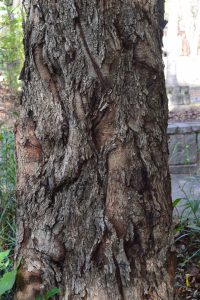
Propagation of Carya is principally by seeds and grafting/budding. The latter a common method for cultivars of pecan. Squirrels may be the best seed dispersal agents, for seedlings, particularly pecans, appear weed like in the southeast. I collect nuts in October-November, place several in well drained, bark medium in 3-gallon containers, cover 1 to 2”, and protect from animals with a screen. Seedlings require a cold period and are left outside. Germination takes place the following spring. The individual seedlings are then transplanted during the next winter to 3-gallon containers, the tap root pruned to half or more its length. I know a nursery that roots cuttings of Carya aquatica by harvesting juvenile shoots that develop after transplanting trees from the field. The holes are not filled, and adventitious shoots develop from the severed roots that remain at the edges. This method could be applied to other Carya species.
Carya species are adapted to wet (Carya aquatica), sandy/dry rocky slopes and ridges (Carya tomentosa), and silt loam to clay (Carya glabra, Carya laciniosa, and Carya ovata). If they were easy to transplant, hickories would be available in greater numbers. Hickories are essential components of the North American deciduous forest ecosystem and, with oaks, maples, birches, tupelos, elms, walnuts, tuliptree, beech, and sweetgum, command and deserve to be planted and preserved.
I recommend purchasing small bare-root seedlings or containerized material. Several growers/retailers from whom I purchased hickories and other native trees include Superior Trees, Lee, FL (superiortrees.net), Mail Order Natives, Lee, FL (mailordernatives.com), Forrest Keeling Nursery, Elsberry, MO (fknursery.com). Hillis Nursery Company, Inc., McMinnville, TN, (hillisnursery.com) offers six Caryaspecies. Melanie Wells, Mount Vernon, provided additional online nurseries that supply Carya species (americanheritagetrees.org and whitehousenatives.com).
The best adapted and available Carya species for garden and native plantings include the following.
They are presented by bud and leaf characteristics. Carya aquatica, C. cordiformis, and C. illinoinensis have valvate terminal buds meaning the bud scales meet at their edges but do not overlap, the terminal larger than the lateral buds. The leaflets, the same size throughout.
Carya glabra, C. laciniosa, C. ovata, and C. tomentosa with bud scales overlapping. Leaflets fewer, the terminal leaflet larger than the laterals, often 2 to 3 times. Terminal buds larger than laterals.
Carya aquatica, water hickory, is a beautiful tree with finer textured foliage and branching habit than those that follow. There are typically 9 to 11, 2 to 3” long, equal sized leaflets. Leaves are rich green, turning soft to bright yellow in autumn. I noticed leaves still persisting on trees in Athens as late as mid-November. The nut is 1 to 1 ½” long, broadly ovoid, and four-winged along the seams. The kernel is bitter. The rich brown bark develops scaly plates, not as prominent as those of C. laciniosaand C. ovata. I noted a 70’ high tree at the Coker Arboretum, University of North Carolina, Chapel Hill. National champion is 97’ by 62’. Common in swamps and along rivers from Virginia to Texas. This has been the easiest hickory to transplant balled-and-burlapped. Zone 6 to 9.
Carya cordiformis, bitternut or swamp hickory, has seldom crossed my path, although native to every state (except Maine) east of the Mississippi and nine contiguous states west of the mighty river. I remember trees at Middlebury College, Vermont, University of Illinois, Champaign-Urbana, IL, and in June 2022, Mount Vernon, VA. Initially, I was not positive about the identification of the Mount Vernon Carya, until Melanie Wells, horticulturist, sent a photo of the sulfur yellow buds. The branches were so high, I could not accurately count leaflet numbers (typically 7 to 9, ~equal size) or determine bud color. Melanie mentioned that the tree was previously identified as C. tomentosa. The light green, slightly falcate leaflets are 3 to 6” long, ¾ to 21/2” wide, turning rich golden yellow in fall. The suborbicular nut is 11/4” long, 4-winged or ridged, often only above the middle, the seed bitter. Typically, a slender tree with an irregular, cylindrical crown of stiff ascending branches, widest at the top. This habit description could be superimposed on the Mount Vernon specimen. Bark is gray-brown, smooth initially, developing low narrow interlacing ridges, occasionally with a few scales. I estimate 50 to 75’ high, slightly less in spread. National Champion is 106’ high and 100’ wide. Considered the fastest growing of the hickories. In the wild, most often found in low woods, less frequently in uplands, although the USDA profile describes it being found on rich, loamy or gravelly soils, low wet woods, borders of streams, and dry uplands. Zone 4 to 9.
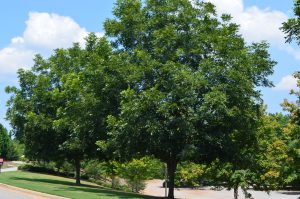 Carya illinoinensis, pecan- Although not native in Georgia, it is major cultivated nut crop with a value of 182.5 million in 2021. Seedling trees are like mushrooms and appear everywhere, producing reasonable quantities of edible nuts. The modern pecan industry relies on improved cultivars and thousands of acres were planted in the last 10 to 15 years. Leaflets vary from 11 to 17, each 4 to 7” long, 1 to 3” wide, the midvein slightly curved, resulting in the term falcate. About the easiest Carya to identify by foliage. Leaves are lustrous dark green, persisting late into November (Athens), occasionally with a wisp of yellow fall color. The thin-shelled, ellipsoidal, brown nuts, tapered at their ends, average 1 to 2” long and are held in a four-valved, winged, dehiscent husk. Nuts dehisce in November in the Athens area and can be readily gleaned. Plant in moist, well drained, deep soil, although stray seedlings take hold under myriad conditions. The lateral buds resemble toasted almonds in shape and color. They are held at 45-degree angles to the stem. Bark is gray-brown, somewhat scaly on mature trunks. A large tree, 70’ and beyond, and certainly not for small properties. National champion is 97’ by 106’. In nature, the species inhabits low areas along water courses from Indiana to Texas. Zone 5 to 9.
Carya illinoinensis, pecan- Although not native in Georgia, it is major cultivated nut crop with a value of 182.5 million in 2021. Seedling trees are like mushrooms and appear everywhere, producing reasonable quantities of edible nuts. The modern pecan industry relies on improved cultivars and thousands of acres were planted in the last 10 to 15 years. Leaflets vary from 11 to 17, each 4 to 7” long, 1 to 3” wide, the midvein slightly curved, resulting in the term falcate. About the easiest Carya to identify by foliage. Leaves are lustrous dark green, persisting late into November (Athens), occasionally with a wisp of yellow fall color. The thin-shelled, ellipsoidal, brown nuts, tapered at their ends, average 1 to 2” long and are held in a four-valved, winged, dehiscent husk. Nuts dehisce in November in the Athens area and can be readily gleaned. Plant in moist, well drained, deep soil, although stray seedlings take hold under myriad conditions. The lateral buds resemble toasted almonds in shape and color. They are held at 45-degree angles to the stem. Bark is gray-brown, somewhat scaly on mature trunks. A large tree, 70’ and beyond, and certainly not for small properties. National champion is 97’ by 106’. In nature, the species inhabits low areas along water courses from Indiana to Texas. Zone 5 to 9.
Carya glabra, pignut hickory. I grew up with this species in southern Ohio where it was quite common. It has a tapering trunk and a regular, open, oval head of slender contorted branches. Finer texture than C. laciniosa, C. ovata, and C. tomentosa. Leaves are composed of 5 to 7 (typically 5), lustrous dark green leaflets. Each 3 to 61/2” long, 1 to 2” wide, the lower pair one-third the size of the terminal. Leaves turn beautiful golden yellow in fall. Nuts are subglobose, ¾ to 11/4” long, the seeds with a bitter taste. The bark is smooth, gray-brown on young trees, eventually developing rounded ridges, intersecting to form a diamond shaped pattern. Landscape size approximates 50 to 60’ high and 25 to 35’ wide although the National Champion is 149’ by 75’. Common in nature in drier habitats, upland soils, and rocky areas. Zone 4 to 9.
Carya ovata, shagbark hickory, is one of my favorite Noble Trees which should be planted in every park, golf course, open area from Canada to Florida and west to Missouri and Texas. The bark, composed of gray-brown shaggy scaly plates, free at both ends, curving away from trunks, makes for easy identification. The deep green leaves, comprised of five, rarely seven, 4 to 6” long, ½ to 21/2” wide leaflets, turn saturated golden yellow to golden brown in fall. Nuts, nearly round, 1 to 11/2” diameter, shell angled, husk ¼ to 1/3” thick, freely splitting at maturity, no winged suture lines, enclose edible, sweet seeds. Shelled shagbark hickory nuts sell for $9.99 per ounce or $19.99 dollars for three ounces from hickorynutsdirect.com. Species develops a straight, cylindrical trunk, with an oblong crown of ascending and descending branches (like C. laciniosa). In the wild, is found in drier upland slopes and deep well drained soils in lowlands and valleys over most of eastern North America. I have observed magnificent trees in urban, suburban and natural areas. Have yet to be disappointed by performance. Estimate 60 to 80’ high. National Champion is 104’ by 99’. Zone 4 to 8 (9).
Carya laciniosa, shellbark hickory, differs from C. ovata in leaflet number, primarily 7, and the absence of tufts of pubescence (hairs) near the tips of serrations. Buds, bark, nuts (sweet seeds) are similar. Safe to state, I am never sure about positive identification between this and C. ovata until examining the leaves. Estimate 60 to 80’ in height; the National Champion 109’ by 112’. Found in bottomlands and floodplains, New York to Alabama to Missouri and Arkansas. Not as common as C. ovata. Zone 5 to 8.
Carya tomentosa, mockernut, white hickory, is a common species over most of eastern North America. The leaves and stems are covered with brown pubescence which persists and permits easy identification. The leaves are composed of 7 to 9 leaflets, the upper pair 5 to 9” long, 3 to 5” wide, the lower pair two-thirds that size. Leaves are dark yellow green, fragrant when bruised, and develop deep golden yellow to golden brown fall color. Nuts are elliptical to rounded, 1 to 11/2” long, angled, with a ¼ to 1/3” husk splitting to the base. The seed is edible. Habit is narrow to broadly rounded. The bark develops interlacing ridges forming a diamond to netlike pattern. Common to dry habitats of uplands, including ridges and hillsides. To 3,000’ in the southern Appalachians. I estimate 50 to 60’ high under landscape conditions. Many trees in the Athens area supersede this size. The National Champion checks in at 140’ high and 85’ wide. Zone 4 to 9.
The other U.S. species are C. floridana, scrub hickory, C. myristiciformis, nutmeg hickory, C. pallida, pale or sand hickory, and C. texana, black hickory.
This mini treatise will hopefully inspire readers to become familiar with Carya, hickories. They are remarkable Noble trees that for too long have flown under the landscape radar. I believe the Chinese Proverb, “The best time to plant a tree was 20 years ago; the next best time is today”, applies to hickories. In my 78th year, I planted a Carya aquatica grown from seed collected at the USDA Germplasm Repository in Beltsville, MD. The quote, “The true meaning of life is to plant trees under whose shade you do not expect to sit”, rings true for my effort.
Cornus is a fascinating genus with species ranging from groundcover habits (Cornus canadensis) to large trees (Cornus controversa). I relate to students and garden visitors that if one dogwood is recognizable, then all can be. The leaves (primarily deciduous, several evergreen) are linear-ovate to ovate to broad ovate, margins entire (no teeth) with veins originating from the midvein and then turning toward the apex, almost paralleling the margin. When the veins are and gingerly teased apart, rubbery strands are evident. Cornus alternifolia and C. controversahave alternately arranged leaves; all others opposite. Now the trick is to accurately identify the ~60 species.
(more…)
Bonnie and I spent a few days at Hilton Head during the week between Christmas and New Year’s. At our fourth-floor condominium, the view from the balcony/porch was part beach but primarily treetop green, the latter Quercus virginiana. The species is the dominant noble tree on the island and efforts to preserve it in the throes of relentless construction activities were remarkably successful. Homes, condominiums, and commercial properties literally mesh cheek to jowl yet are largely shrouded/screened from street view by the majestic oaks. Hilton Head Island has strict Tree Ordinance regulations to protect and preserve this and, what are termed, Specimen Trees. The specifics of the Tree Ordinance are available at hiltonheadislandsc.gov/development/natresources.crm.
I have visited every coastal southern state from Virginia to Texas, and throughout encountered majestic live oaks. Perhaps, the most impressive was the Angel Oak on St. John’s Island, South Carolina, the canopy covering 17,000 square feet, estimated 300 to 400-years-old. I stood there in awe, mesmerized by the architectural majesty and had my picture taken next to the tree (see photo in 2012). Perhaps, the most well-known Live Oak is the iconic specimen at the Augusta National Golf Club between hole 18 and 10. The finishing 18th hole at the Master’s and the Tree are internationally known and beloved.
Let’s dive in and explore what makes the species so magical. More than any other feature, the rounded to broad-rounded, wide-spreading, arching sturdy branches, often draped with “Spanish moss”, render the tree unassailable by the forces of nature. I worked in Charleston after Hurricane Hugo and this and the native palm, Sabal palmetto, were the least affected. To be clear, there was damage on live oak, and large branches that were pruned, developed new shoots and covered the wounds of wind.
Live Oak is 40 to 80’ high at landscape maturity with a 60 to 100’ spread. The national champion, located in Live Oak (actually Savannah), Georgia, is 78’ high, 161’ in crown spread, with a trunk circumference of 440” (last measured in 2019). The location is easily referenced on Mapquest. Obviously, it is not a wise choice for small properties. What I find so remarkable is the secondary spreading branches, as large as a “normal” tree trunk, are steel cable strong and flexible. At one time, the government held maritime forest of live oak in Florida to use for ship building. The wood is the heaviest of all oaks, a cubic foot weighing 75 pounds.
The massive trunks and branches are an ecosystem unto themselves. I remember the epiphytic bright green resurrection fern, Pleopeltis polpodioides, blanketing the tops of the branches of the Angel Oak. The ferns do not extract water or nutrients from the host plant. When dry, the fronds shrivel and turn gray-brown, only to “resurrect” themselves when moisture is available. The bark is brown-black, vertically and horizontally fissured, with the texture of alligator hide. Quite easy to identify a mature live oak from a distance by habit, low slung branches, and bark pattern.
The mature evergreen foliage is saturated lustrous dark green, persisting into spring, abscising as the new olive-green foliage unfurls. Leaves average 1 to 3” (5”) long, ½ to 1/1/2” wide, the leaf undersides grayish, the margins revolute (rolled under). The juvenile foliage on seedlings has spiny margins and looks nothing like the mature foliage. I have grown numerous seedlings and the leaves resemble a spiny holly in appearance. The foliage displays a measure of salt tolerance.
The acorn is torpedo/bullet-shaped, ¾ to 1” long, brown/black, maturing in a single season as it is a member of the white oak group. Fruits ripen in fall and should be collected when turning brown. I noticed significant weevil infestation manifested by tiny circular holes in the nut. Birds and animals eat the acorns. A partial list includes northern bobwhite, Florida scrub jay, mallard, sapsuckers, wild turkey, black bear, squirrels, and white tailed deer.
The species is native from Virginia to Florida, west to Oklahoma and Texas, into Mexico. Found in coastal sandy soils, to moist rich woods. Trees on Jekyll Island, Georgia, sculpted by the wind and salt spray, lower on the ocean side, taller behind, and appear to be leaning toward the beaches.
In part 2, I will discuss the hybrids, propagation, production, landscape uses, botanical varieties, and cultivars.




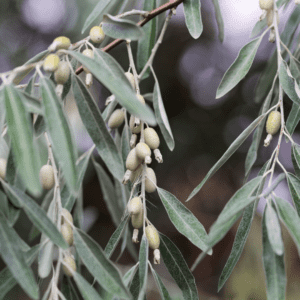
Michael A. Dirr
HMI requested a brief discussion on salt tolerance in woody plants. I started my career at the University of Illinois, Urbana, in 1972 after graduation from the University of Massachusetts. While a student at UMass, I was introduced to Acer saccharum, sugar maple, decline, at least partially attributable to deicing salts. The conundrum has always been that people demand safe highways and healthy trees. There were many research papers on the subject, particularly from UMaine researchers. The decline, manifested in stagheaded sugar maples, was reported as early as 1917 in Massachusetts. The decline was not solely attributable to deicing salts but myriad interactive factors including drought, insects, diseases, and certainly salt. An updated review (2018) of Maple Decline: various factors is available at www.plantclinic.cornell.edu/factsheets/mapledecline.pdf.
At Illinois, I visited with the highway personnel in the Chicago area. Many of the trees along the freeways were stag-headed/witches-broomed, particularly the side closest to the highway where aerial salts were deposited on the stems and resulted in dieback and miserably mis-shaped trees and shrubs. At the time I was constructing lists of trees/shrubs, good (not many) and bad (many) along the freeways, a rare grass surfaced in the ditches/swales where salt runoff accumulations reached 5%. For comparison, seawater is 3.5% salt, largely NaCl. Puccinellia distans, alkaligrass, was identified, and resulted in the commercial cultivar ‘Fults’. This development was carried out by Colorado State researchers. Point being salinity can change the ecology of an area.
Many Malus, crabapples, and Crataegus, hawthorns, were planted and none showed resistance. Gleditsia triacanthos f. inermis, honeylocust, and Elaeagnus angustifolia, Russian-olive, were in good health. Why the disparate performance when all trees/shrubs were subjected to similar levels of deicing salts. The penultimate question, and I conducted many greenhouse experiments to understand the mode of action of salt. Salt damage occurs from aerial deposits, soil salinity, and combinations. Honeylocust was the initial test plant based on freeway performance and proved quite remarkable in its ability to avoid accumulating high concentrations of sodium or chloride. I speculated the salt tolerance to the inability of Na and Cl ions to penetrate the waxy stems and protected buds of dormant trees. I did not record a single honeylocust on the highways with the witches-brooming common on most trees. Soil applications to honeylocust resulted in severe injury. Shoot content of chloride was a reliable index to the degree of salt injury, because the greater the tissue Cl, the more rapid was the onset and the more severe the injury. See HortScience 9:53-54. Tolerance of honeylocust seedlings to soil-applied salts. 1974.
I screened many needle evergreens and the same Cl relationship was evident. Needles of Pinus strobus, white pine, and P. thunbergii, Japanese black pine, were treated with foliar-applied salts to runoff. White pine was severely injured with 4% needle Cl; Japanese with less injury and 2% needle Cl. Anatomical investigations showed Japanese black pine had thicker cuticle (waxy covering) and the subepidermal cells were heavily impregnated with thickenings, thus more resistant to aerial Cl penetration. On Cape Cod, P. thunbergii has naturalized at the Truro Highland Lighthouse area were exposed to full force of the Atlantic. Townsend and Kwolek (J. Arb. 12: 25-228. 1987) evaluated susceptibility of thirteen pine species to sodium chloride spray. Pinus thunbergii was most tolerant; P. strobus least. Overall, species with lowest Na and Cl levels were the most tolerant.
In all my research, the chloride ion always proved most lethal; sodium less so. Comparative studies with potassium chloride (KCl), calcium chloride (CaCl2), and sodium chloride (NaCl) definitively pointed to Cl as the toxic element.
Many salt tolerant tree and shrub lists are available on line. The Journal of Arboriculture research publications are available. My “Selections of trees for tolerance to salt”, J. Arb. 11:209-216 is a solid review of salinity and woody plant injury and includes a listing of salt tolerance (good, moderate and poor), for 134 genera and species.
Since moving to Georgia 42-years ago, the salt research ceased but when I visit the coast, the effects of salinity are evident on the native as well as the introduced ornamental woody plants. Live oak, Quercus virginiana, is considered salt tolerant. However, many specimens facing the ocean have been sculpted by salt spray. I believe that any woody plant is susceptible to damage depending on the concentration and length of exposure.
Cornus officinalis-Japanese Cornel Dogwood.
Michael A. Dirr
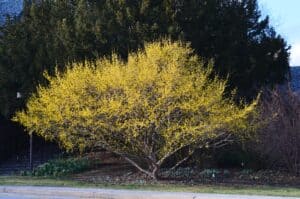
The Japanese cornel dogwood is a beautiful small tree, the yellow flowers borne on spur-like naked stems months ahead of the foliage, harbingers of Spring’s awakening. I suspect after the 2020 pandemic, people are looking for signs of hope in the New Year. Gardening provided that to a large segment of U.S. society in 2020 and signs point to robust plant sales in 2021. I have always grown tomatoes, peppers, cucumbers, squash and the like but those are spring-summer ephemeral pursuits. Woody plants offer year-round presence with foliage, flowers, fruits, bark, and architecture/branching patterns. Few trees have the floral persona of Cornus officinalis and, walking the garden on 1-12-21, the flower buds opening, exposing the mustard yellow petals, inspired me to pen this essay.
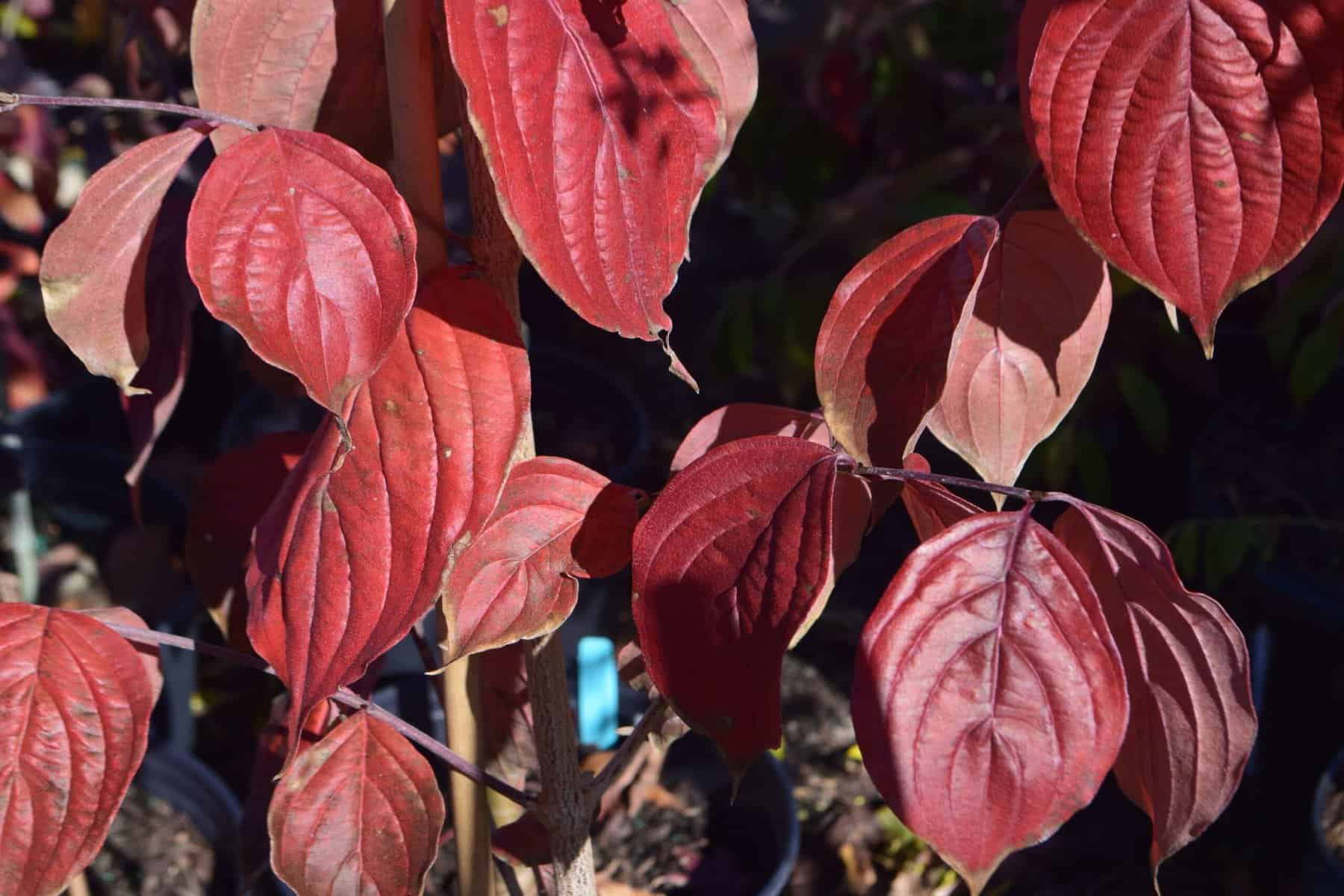
The species is restrained in habit, 15 to 25’ high and wide. The majority of specimens I cataloged were wider than tall. The Secrest Arboretum, Wooster, OH, reported a 46-year-old tree was 22’ high and 35’ wide. A specimen in a local Athens garden is 18’ by 22’. In many characteristics, the species is similar to Cornus mas, Corneliancherry dogwood, except flowers are 7 to 14 days earlier, the fruit matures later (September), the foliage may have brown tufts of pubescence in the lower vein axils, and the bark exfoliates in rich gray, brown and orange. The bright cherry red fruits are rather insipid and have not been domesticated for culinary purposes like those of C. mas. The winter silhouette is more refined than C. mas.
The foliage is lustrous dark green and may develop reasonable red -purple fall color. A selection (‘Morton’) from the Morton Arboretum, Lisle, IL, colored pretty red in the Dirr garden. The foliage is insect and disease resistance, persisting into October-November in zone 8.
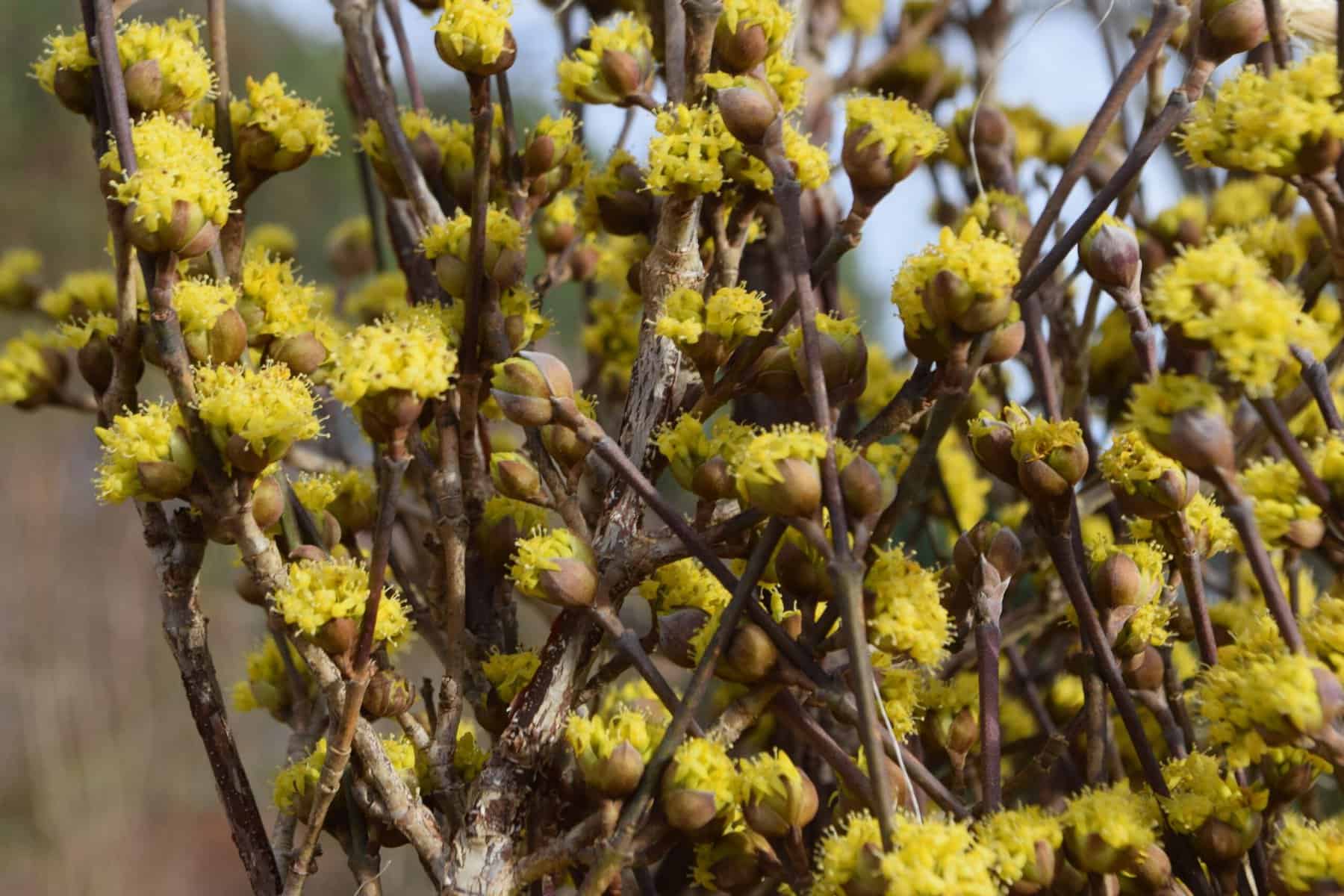 Flowers peek through ¼” long, rusty brown, pubescent, rugby ball-shaped buds in January-February, fully open in February-March and long persistent. Inflorescence is an ¾” wide umbel carrying 1/6” diameter, sulfur/mustard yellow flowers in supernumerary abundance. The tree, from a distance, glowing yellow when most trees and shrubs are in winter’s gray/brown garb. Fruit is a cherry red, oblong drupe, ½ to ¾” long, ripening in late summer. At the U.S. National Arboretum, fruits persisted into March as flowers were opening (photo). The fruits are called “zhu yu” or “zoa pi” in Chinese medicine and prescribed as an astringent tonic for impotence, lumbago, vertigo and night sweats.
Flowers peek through ¼” long, rusty brown, pubescent, rugby ball-shaped buds in January-February, fully open in February-March and long persistent. Inflorescence is an ¾” wide umbel carrying 1/6” diameter, sulfur/mustard yellow flowers in supernumerary abundance. The tree, from a distance, glowing yellow when most trees and shrubs are in winter’s gray/brown garb. Fruit is a cherry red, oblong drupe, ½ to ¾” long, ripening in late summer. At the U.S. National Arboretum, fruits persisted into March as flowers were opening (photo). The fruits are called “zhu yu” or “zoa pi” in Chinese medicine and prescribed as an astringent tonic for impotence, lumbago, vertigo and night sweats.
Culturally, the species is adaptable to extremes of soil except wet. Container-grown material is readily transplanted and Bold Spring Nursery, Hawkinsville, GA, provides B-and-B of ’Kintoki’. Hawkinsville is 100 miles south of Atlanta and trees I observed on 11-9 were lustrous dark green with no sign of heat stress. The reader might surmise I am building a case for use, North and South. In my Manual, zone 5 to 8 was ascribed to the species. I believe it could be moved into lower zone 4. In the Chicago area, Roy Klehm, championed the species through Song Sparrow Nursery, and introduced at least four selections (see cultivars).
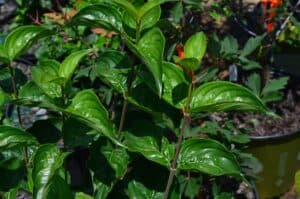 Propagation from cuttings has been hit or miss for the author. Germinated many seedlings which formed flower buds in the second year. The cultivars are either grafted or rooted from cuttings.
Propagation from cuttings has been hit or miss for the author. Germinated many seedlings which formed flower buds in the second year. The cultivars are either grafted or rooted from cuttings.
Native to Japan and Korea, covering almost the whole of Japan; two-thirds of Korea. In China, habitat is described as forests, forest margins and mountain slopes, from 1,300 to 7,000’ elevation. Considering the extensive geographic range, it is surprising more wild-collected material was not introduced in the U.S.
Cultivars: The following are listed in the literature with only ‘Kintoki’ widely available in the U. S.
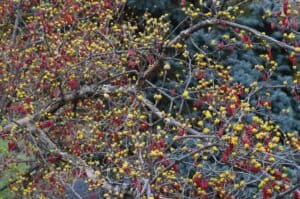 ‘Aurea’ from the Netherlands is described as having golden yellow leaves with shades of green mixed with the yellow. Have not seen and the description makes little sense.
‘Aurea’ from the Netherlands is described as having golden yellow leaves with shades of green mixed with the yellow. Have not seen and the description makes little sense.
‘Issai Minari’ flowers heavily as a young plant.
‘Kintoki’ produces abundant bright yellow flowers in early February in the Dirr garden. Reliable year-in, year-out. Upright in youth, more open at maturity. Bark is more exfoliating than everyday seedlings.
Klehm’s introductions include Cheer™ (‘KROY’), Joy™ (‘LROY’), Red Sentinel™ (‘KLMQQ’), and Rugged Charm™ (‘KLMII’). Rugged Charm™ has lustrous dark green foliage (no fall color) and has been a reliable performer in the Dirr garden. I also grow Red Sentinel™. All are listed as 15 to 25’ high. No longer offered as Song Sparrow is closed.
‘Lemon Zest’ (‘Morris Arboretum’) has superior flower size.
‘Morton’ is red fall coloring selection from the Arboretum. I was given a plant for testing and, indeed, fall color was pretty red in the Dirr garden. Do not know release date or fancy name. It was derived from open-pollinated seed.
‘Robins Pride’ produces extraordinary quantities of large yellow flowers. It is listed in the Royal Horticultural Society Plant Finder 2020.
From Tennessee comes ‘Sunsphere’ with earlier flowers. n action.
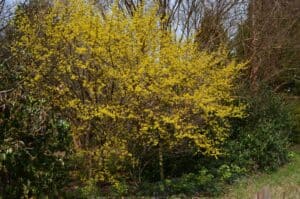
Parrotia persica-Persian Parrotia, Persian Ironwood
Michael A. Dirr
What a great small tree! Roaming the Georgia campus in early March, I notice specks of bronzy green emerging from the dusty gray buds. Leaves will be fully formed by early to mid-April and persist until November-December when fall color signals time to rest. Leaves are tremendously frost resistant to around 20°F. This is also true for Fothergilla, Hamamelis, Disanthus, and other Hamamelidaceae taxa (witch-hazel family members).
The remarkable aspect of the early leafing campus trees is their survival, three in a triangular traffic island: hot, dry, compacted (as students walk between the trees). For over 40-years they have defied the laws of stress. Why not more widely utilized? From Boston to Chicago to Portland and south to Athens, successful plantings are known to the author and improved cultivars are coming online.
Every street, park, golf course, campus, and garden have niches for Parrotia. The new Dirr garden has five P. persica and the recent introduction, P. subaequalis, Chinese parrotia. Traveling and literature treasure hunts have unearthed more cultivars than I knew existed (see below). In February, I walked rows of seedling Parrotia persica at John Malone’s Summershade Nursery, Good Hope, GA. Variation in leaf retention, most with brown leaves, enough without, that this would be a quality selection trait, also tied to fall color. In a previous Dirr garden, the seedling Parrotias ranged from yellow to orange-red, but never consistent. A brilliant, listing toward red selection, would have market prominence akin to the best red maple cultivars like October Glory® and ‘Red Sunset’.
Parrotia persica is native to the Caspian forest of Northern Iran and Azerbaijan where 60’ tall trees are recorded. Too often in cultivation the species is low-branched and multi-stemmed. Single-trunked trees suffice as small street and lawn elements. I envision an allée along a garden path, the lowest branches five feet above the ground, the beautiful exfoliating gray, cream, green barked trunks a treasured accent.
Typically, height ranges from 20 to 40’, spread 15 to 30’, yet I observed many specimens wider than high. The tallest was ~60’ high at the Jardin des Plantes, Paris; wide-spreading specimens, often with multiple trunks, were noted at the Arnold Arboretum, Wisley and Kew Gardens (England), Maymont (Richmond, VA), and Biltmore House and Gardens. The mature, large-trunked trees develop the exfoliating bark mentioned above. Branches show this character in the 4 to 8” diameter range.
Newly emerging leaves are reddish purplish or with a marginal purplish halo (margin), lustrous medium green to dark green in summer, with yellow, orange, red, solely or in permutations in fall. Leaves are broadly oval to obovate, 21/2 to 5” long, 1 to 21/2” wide, serrated above the middle, with an undulating leaf surface, the veins deeply impressed, the leaf base oblique. Foliage withstands all manner of abuse, but Japanese beetles relish the leaves.
Flowers and fruits do not overwhelm. The former, apetalous, either male or hermaphrodite (male and female parts) open on naked stems in February-March, composed of 5 to 15 crimson-maroon stamens, that provide a dollop of color. The woolly, brown, two-valved dehiscent capsule, ½” high, contains two, 3/8” brown seeds. Seeds are released (ejected) at maturity so must be collected before the capsule opens. Tremendous fruit set occurred on ‘Jennifer Teats’ (upright form) growing next to a seedling at the University’s Horticulture Farm. I missed the collection mark, but this was the most abundant fruit set ever observed by the author. Are two different clones, in close proximity, necessary for cross pollination? On anther occasion, seeds were collected, germinated and seedlings developed into wider spreading trees than ‘Jennifer Teates’. Six of these seedling trees (now 15’ high) in the Dirr garden develop yellow to golden orange fall color without a trace of red.
Widely and wildly adaptable to sun, shade; acid, neutral, moist to drier (as previously mentioned) soils. British references point to its adaptability to chalk (limestone). Readily transplanted from containers or balled-and-burlapped and adaptable from zone 4 to 8, to 9 on West Coast.
With the above quality character traits, why is the species limitedly available? I can’t remember a Parrotia persica at any big box store although high-end garden centers occasionally stock the species. Propagates readily from cuttings and has been rooted numerous times in my shop. Ideally firm, May-June cuttings with 3,000 ppm IBA, light fertilizer after rooting and extended photoperiod to induce a growth flush and subsequent overwinter survival. Seeds require 3 month warm/3 month cold stratification to promote germination. Appears more like Fothergilla for germination requirements rather than simply sowing fresh seed of related taxa like ×Sycoparrotia semidecidua and Distylium species and up they come.
Quixotic assortment of cultivars including weeping, upright, and variegated selections. The list includes ‘Bella’ (leaves with dark red to purple tints; autumn color wine red), ‘Biltmore’ (100-year-old plant, wide-spreading habit, beautiful bark), ‘Burgundy’ (young growth flushed purple; superb deep burgundy autumn color, from Junker’s Nursery, UK), ‘Cobhay Upright’, Contemplation® (‘PPCM2’), ‘Felicie’ (superb autumn color), ‘Globosa’, Golden Belltower® (‘Chrishaven1’) (appears similar to ‘Vanessa’), ‘Henny’s Dwarf’ (in Dirr garden and now 15’ high; not dwarf), ‘Het Plantsoen’, ‘Horizontalis’, ‘Jennifer Teats’, ‘Jodrell Bank’ (upright habit), ‘Lamplighter’ (cream-green variegated, unstable), ‘Pendula’ (described below), ‘Persian Carpet’, Persian Spire® (‘JLColumnar’) (tight, narrow pyramidal habit with good orange-red fall color), ‘Purple Halo’, ‘Purple Moon’, ‘Purple Rim’, Ruby Vase® (‘Inge’), Streetwise® (‘PPS551’), ‘Summer Bronze’, and ‘Vanessa’ (consistent golden yellow fall color). Additionally, several unnamed forms are cloistered in gardens and nurseries.
‘Jennifer Teats’ and ‘Vanessa’ are upright forms with superior foliage compared to row-run seedlings. The latter developed rich golden yellow fall color in late November-early December in our garden. For areas where lateral room is restricted, both make great elements. In fact, logic says (to me) that they may be better choices than the ubiquitous Carpinus betulus ‘Fastigiata’, upright European hornbeam.
The Kew weeping form is the best I know as it truly weeps. Hillier Manual, 2019, describes ‘Pendula’ as “slowly developing into a dome-shaped mound, 6 to 10’ high, becoming a richly colored pile in autumn”. Several semi-weepers to almost plagiotropic branch forms that neither weep nor inspire are known.
Originally chanced upon ‘Ruby Vase’ on the West Coast at Schmidt Nursery, Boring, OR, the new leaves ruby-red, yellow-orange fall color, habit upright vase-shaped, 28’ high by 16’ wide. I see this offered more than the others.
The purple-leaf types do not hold the color as the leaves mature, perhaps a tinge of purple on the margins, but I believe that a seedling from these could be the ONE with persistent purple foliage like one of the purple-leaf European beeches.
The tenor of this article should resonate with readers that any Persian parrotia or ironwood is a worthy garden/landscape element. Contemplation®, ‘Jennifer Teats’, Persian Spire®, ‘Vanessa’ and ‘Henny’s Dwarf’ are part of the Dirr garden and I hope to add others. In fact, assembling a collection of cultivars would make for an exciting treasure hunt and old-age activity. More exciting than shuffle-board!
The red buckeye is among the most beautiful eastern North American tree species, especially in flower, when the brilliant red panicles glow in the woodsy understory. The species occurs naturally in pinela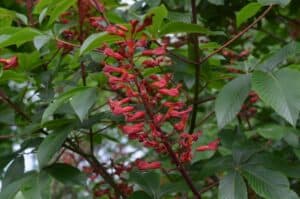 nds, pine-deciduous woods, wooded bluffs, stream banks and bottomlands throughout the range. The USDA Plants Database shows distribution in the wild from North Carolina to Florida west in an arc to West Virginia Kentucky, southern Illinois, southeast Missouri dipping into Texas. I observed numerous plants along coastal South Carolina and Mobile Bay, Alabama, growing in sandy soils. Based on the southern distribution, one could assume lack of hardiness, yet plants in gardens and arboreta survived -20°F and below. Spring Grove Arboretum, Cincinnati, OH, has many beautiful specimens that have experienced below -20°F through the years. The species is successful at the Morton Arboretum, Lisle, IL, which in the 2018-19 winter recorded -24°F. The Minnesota Landscape Arboretum, Chanhassen, MN, grows ‘Atrosanquinea’, a bright red-flowered cultivar.
nds, pine-deciduous woods, wooded bluffs, stream banks and bottomlands throughout the range. The USDA Plants Database shows distribution in the wild from North Carolina to Florida west in an arc to West Virginia Kentucky, southern Illinois, southeast Missouri dipping into Texas. I observed numerous plants along coastal South Carolina and Mobile Bay, Alabama, growing in sandy soils. Based on the southern distribution, one could assume lack of hardiness, yet plants in gardens and arboreta survived -20°F and below. Spring Grove Arboretum, Cincinnati, OH, has many beautiful specimens that have experienced below -20°F through the years. The species is successful at the Morton Arboretum, Lisle, IL, which in the 2018-19 winter recorded -24°F. The Minnesota Landscape Arboretum, Chanhassen, MN, grows ‘Atrosanquinea’, a bright red-flowered cultivar.
The species is utilized as an understory plant in the Dirr garden, residing in the towering canopy of white oak, tupelo, and sweetgum. In this shade environment, trees are smaller and more open. Flowering is moderated a degree but still respectable. The habits of open-grown trees vary from oval-rounded to rounded, usually clothed with dense branches and large compound palmate leaves. Landscape size ranges from 15 to 25’ in height with similar spread. The National Champion (2019) was 48’ high and 37’ wide and resided in St. Louis, MO. I was asked many years past how I determined tree sizes in the Manual of Woody Landscape Plants. I typically reduced champion sizes by 50%. Not a bad rule of thumb for landscape sizes.
The foliage is beautiful, especially the early emerging leaves in riotous colors of green, purple-green, purple, yellow, orange, red, bronze and other permutations (see photo). The effect is ephemeral for the foliage soon becomes shiny dark green. Fall color is yellow at best, assuming there are persistent leaves. The anthracnose/blotch often defoliates trees by late summer. Each leaf is composed of 5 to 7, doubly serrate leaflets, to 6” long.
Flowers, pure red in the best incarnation, open with the emerging foliage in late April (Athens). They remain effective for two weeks or longer, depending on temperatures. The individual tubular flowers, 11/2 to 2’” long, are borne in a 6 to 8” long panicles at the ends of the shoots. Flowers are pollinated by the ruby-throated hummingbirds. A tree in resplendent flower is the tonic of spring. Red buckeye hybridizes with A. flava, A. glabra, and A. sylvatica, the result a mixed bag of flower colors.
The fruit is a large, smooth-skinned dehiscent capsule with one/two shiny rich brown seeds. As soon as the capsule starts to split, they should be collected and the seeds removed. Plant immediately as seeds will quickly wither. I sow seeds in 3-gallon containers filled with pine bark, cover with one-inch of bark, protect from predators, and leave outside. The root radical emerges soon after planting; the shoot the following spring. The seedlings are divided in late fall, tap root pruned, and transplanted to 3-gallon containers. The seedlings often flower in the second or third year.
Certainly, an adaptable species and can be grown in acid or high pH, sandy to clay-based soils with moderate moisture. Does show drought stress and requires supplemental water. The worse-case scenario is the leaves abscise but the tree bounces back the next year. I wish the species were more available in garden center commerce.
Aesculus pavia and A. hippocastanum hybridized in cultivation, largely without the hand of the breeder, to produce A. ×carnea, the red horsechestnut, and the cultivars ‘Briotii with deeper red flowers, ‘Fort McNair’ with lighter pink flowers and greater leaf blotch resistance, and ‘O’Neil’s Red’ with close to red flowers. ‘Briotii’ is one of Bonnie’s favorite flowering trees, consistently flowering in the garden since planting in 2013.
I have always loved the buckeyes and horsechestnuts and perhaps this small essay with inspire others to engage with the genus.
